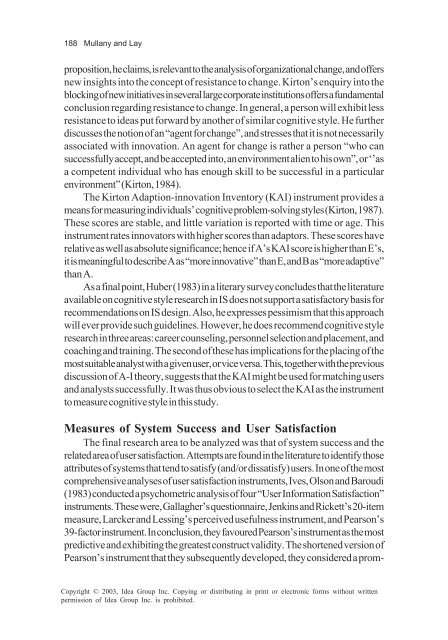www.sharexxx.net - free books & magazines
www.sharexxx.net - free books & magazines
www.sharexxx.net - free books & magazines
You also want an ePaper? Increase the reach of your titles
YUMPU automatically turns print PDFs into web optimized ePapers that Google loves.
188 Mullany and Lay<br />
proposition, he claims, is relevant to the analysis of organizational change, and offers<br />
new insights into the concept of resistance to change. Kirton’s enquiry into the<br />
blocking of new initiatives in several large corporate institutions offers a fundamental<br />
conclusion regarding resistance to change. In general, a person will exhibit less<br />
resistance to ideas put forward by another of similar cognitive style. He further<br />
discusses the notion of an “agent for change”, and stresses that it is not necessarily<br />
associated with innovation. An agent for change is rather a person “who can<br />
successfully accept, and be accepted into, an environment alien to his own”, or ‘’as<br />
a competent individual who has enough skill to be successful in a particular<br />
environment” (Kirton, 1984).<br />
The Kirton Adaption-innovation Inventory (KAI) instrument provides a<br />
means for measuring individuals’ cognitive problem-solving styles (Kirton, 1987).<br />
These scores are stable, and little variation is reported with time or age. This<br />
instrument rates innovators with higher scores than adaptors. These scores have<br />
relative as well as absolute significance; hence if A’s KAI score is higher than E’s,<br />
it is meaningful to describe A as “more innovative” than E, and B as “more adaptive”<br />
than A.<br />
As a final point, Huber (1983) in a literary survey concludes that the literature<br />
available on cognitive style research in IS does not support a satisfactory basis for<br />
recommendations on IS design. Also, he expresses pessimism that this approach<br />
will ever provide such guidelines. However, he does recommend cognitive style<br />
research in three areas: career counseling, personnel selection and placement, and<br />
coaching and training. The second of these has implications for the placing of the<br />
most suitable analyst with a given user, or vice versa. This, together with the previous<br />
discussion of A-I theory, suggests that the KAI might be used for matching users<br />
and analysts successfully. It was thus obvious to select the KAI as the instrument<br />
to measure cognitive style in this study.<br />
Measures of System Success and User Satisfaction<br />
The final research area to be analyzed was that of system success and the<br />
related area of user satisfaction. Attempts are found in the literature to identify those<br />
attributes of systems that tend to satisfy (and/or dissatisfy) users. In one of the most<br />
comprehensive analyses of user satisfaction instruments, Ives, Olson and Baroudi<br />
(1983) conducted a psychometric analysis of four “User Information Satisfaction”<br />
instruments. These were, Gallagher’s questionnaire, Jenkins and Rickett’s 20-item<br />
measure, Larcker and Lessing’s perceived usefulness instrument, and Pearson’s<br />
39-factor instrument. In conclusion, they favoured Pearson’s instrument as the most<br />
predictive and exhibiting the greatest construct validity. The shortened version of<br />
Pearson’s instrument that they subsequently developed, they considered a prom-<br />
Copyright © 2003, Idea Group Inc. Copying or distributing in print or electronic forms without written<br />
permission of Idea Group Inc. is prohibited.









